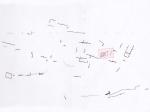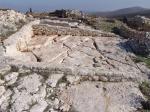Summary (English)
Cvijina gradina was a Liburnian fortified hillfort which, due to its convenient location and its importance, continued to exist even during the Roman era. Like all Iron Age hillforts, it was protected by walls. Although mostly scattered, they can still be clearly seen today on the north-west and south-east. The main entrance through that defensive wall was on the southeast side. On the surface of the hillfort (200 × 70 m) the remains of buildings can be seen, among them are the walls of a temple, forum with usual public buildings, while the settlement was placed on several terraces on the south and southwest sides. There is also a thermal complex with a mosaic floor. On the eastern and southern foothills graves are located.
Excavation in 2005 was directed towards the south-eastern edge of the plateau, where three buildings bordered by two city roads were found. All the adaptations carried out to level the surface for the construction of walls and rooms are clearly visible. The ground plan situation and small finds, among which iron objects are often (locks, nails, large amounts of slag, etc.), prove that a complex of economic production was located here. The residential houses were located on the southern terraces of the settlement, protected from the wind. There are numerous finds of Liburnian and Roman pottery, coins, metal, and other finds. The walls are mostly well preserved, at least 2 to at most 5 – 6 courses of stones (approx. 80 cm high), except in the uppermost courses where the binding material has mostly vanished (Natalija Čondić, Branka Nedved 2006, Hrvatski arheološki godišnjak 2/2005, 299-300).
- Natalija Čondić
- Branka Nedved
Director
- Natalija Čondić
Team
- Branka Nedved
Research Body
- Arheološki muzej Zadar
Funding Body
- Ministarstvo kulture Republike Hrvatske






![Download [PDF]](/excavation/skins/fasti/images/results/download_sml.png)
